How Star Trek: Voyager Failed In The Face Of Easy Success
Star Trek: Voyager failed for many reasons including Kate Mulgrew's off-camera issues, B'Elanna Torres's character flaws, and racism around Chakotay.
Star Trek: Voyager was the fourth Star Trek series to arrive on television. The three which preceded it were all, in their own way, resoundingly successful. Even Star Trek: Deep Space Nine, though it never quite got the ratings of Next Generation, proved to be a solid critical, award-winning success. Then came Voyager.
It’s not that Star Trek: Voyager was a disaster or even bad. The show lasted the Star Trek requisite seven seasons and among those seasons had a few truly inspired moments. Voyager didn’t kill Star Trek but it was the beginning of a trend that would send Star Trek into a deep coma, a coma it would not awake from until 2009’s Star Trek reboot.
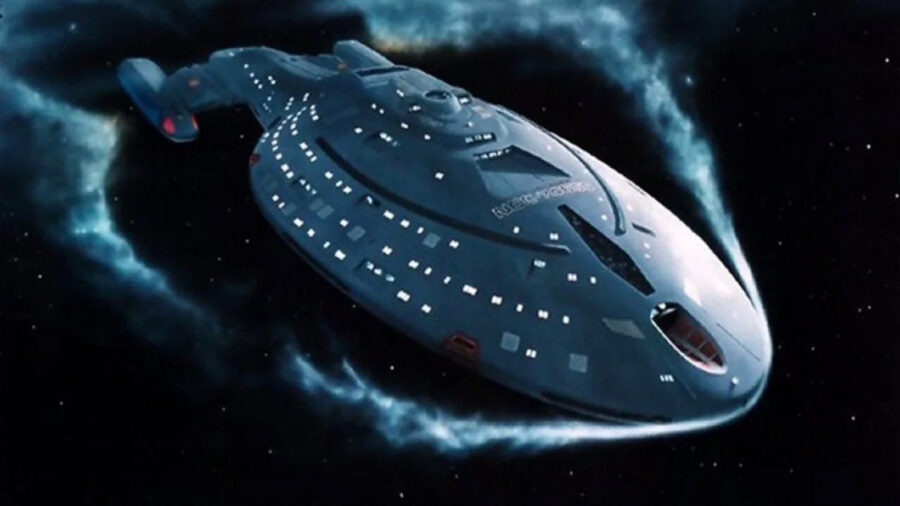
It was in Voyager that we, the franchise’s fans, all started to sense something might be going wrong with Gene Rodenberry’s vision, and it only got worse after Voyager went off the air. The next Trek series, Enterprise, was cancelled early in its run. Few of the Next Generation movies were any good and what’s worse, by the end, few were showing up to see them. Voyager didn’t kill Star Trek but it signified the beginning of the slide. The things which did temporarily stall the franchise, putting it in a tailspin that resulted in the 2009 reboot, all started there.
Here’s why that happened: the biggest reasons Star Trek: Voyager never truly lived up to its huge Star Trek potential.
Janeway Needed To Be More Kirk And Less Picard
In several interviews since the end of the show, Kate Mulgrew, who played Captain Kathryn Janeway on Star Trek: Voyager, has admitted that she never really gave the role her all. It wasn’t that she was disinterested, but her home life was in turmoil, and according to the actress, she was struggling to find a balance between raising a family and having a career.
But Kate Mulgrew wasn’t the problem. It’s the character they came up with for her to play that never quite worked. In creating Star Trek’s first female Captain it seems clear that Voyager’s producers went out looking for a female Picard, when what they should have done is cast a female Captain Kirk.
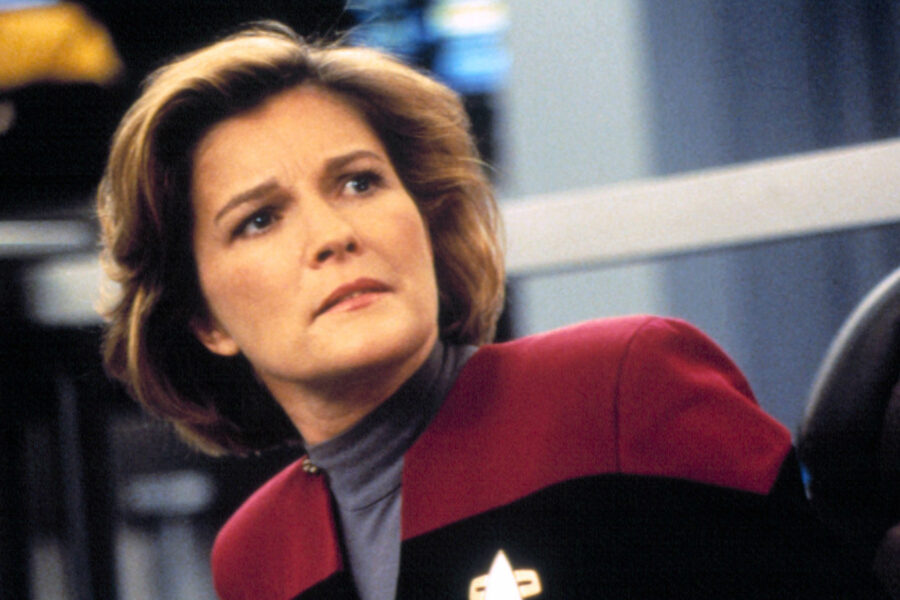
Picard worked brilliantly because he subverted the traditional, Captain Kirk alpha male stereotype. But a female Picard … well, she mostly plays into stereotypes. What they needed was a take-charge, dynamic female Captain; what they gave us was a moralizing, overly liberal pushover all too willing to throw her crew’s life away for no reason at all if it made her seem superior and at least as interested in prancing around in frilly dresses on the holodeck as she is in leading her crew.
Janeway had her moments of crazy toughness and Mulgrew’s performance was passable, but the entire idea behind the kind of Captain Star Trek: Voyager was initially saddled with, was simply wrongheaded from the start. Maybe an actress who was more engaged and focused than Mulgrew was at the time could have done something to make all the pieces fit together.
It’s not Mulgrew’s fault though; it’s not even really most of the writers’ fault. They were stuck with a really bad idea, a bad idea which was unfortunately the most central character on the show, and no one ever really figured out a way to completely erase that starting premise.
B’Elanna Torres Is Meg Griffin
When the Star Trek: Voyager team came up with B’Elanna Torres, I imagine they expected her to be the strong, fiery, balls-to-the-wall, take-no-prisoners female character Janeway should have been consistently. The show is written as though that’s what everyone expects from her. Characters reference her legendary Klingon temper, her unbelievable Klingon toughness, and her intimidating demeanor.
It’s all talk. None of the things Voyager seems to think Torres is, actually ever turn out to be true. Instead, what they got, thanks at least in part to consistently horrible performances from Roxann Dawson, was Meg Griffin. Meg Griffin is the worst character on Family Guy. She exists primarily as a running joke, in which everyone acknowledges how awful she is. That’s B’Elanna.
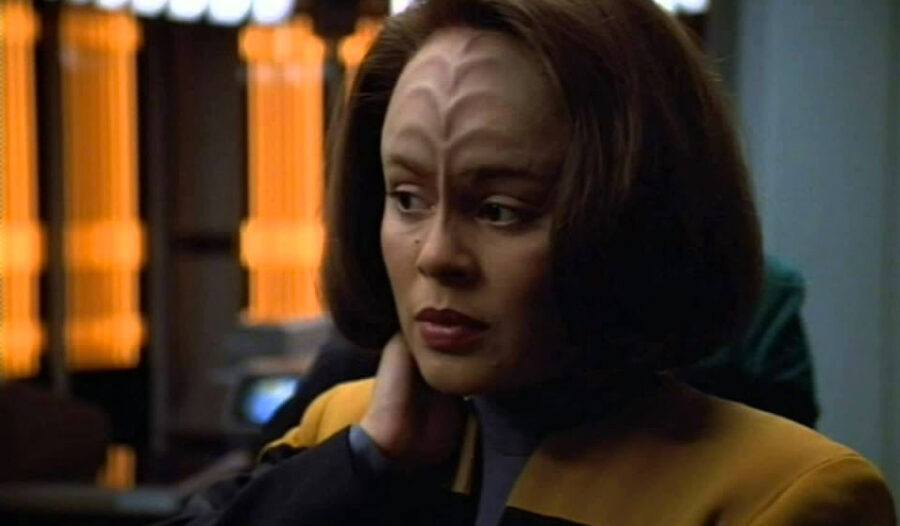
Her legendary Klingon temper never really moves beyond the realm of “bitchy.” Her legendary Klingon toughness is mostly a lot of pouting. If her crew mates are intimidated by her, it’s only because they’re afraid she might start whining before they can get out of the room.
B’Elanna has the uncanny ability to walk into any situation and make it depressing. She takes a dump on any plot she’s involved in and turns the smiles of everyone around her into frowns. Tom Paris excited about an awesome space race? Don’t worry, B’Elanna will force her way into the episode to make sure it turns into a discussion of their relationship and none of that fun racing stuff ever happens.
Everyone happy because she’s having a baby? Don’t worry, B’Elanna’s not and it’s only a matter of time before she starts bitching about how much she hates her unborn kid. Putting B’Elanna Torres in the engine room was like giving Voyager’s warp core cancer. It was only a matter of time before she caused a core breach.
It’s worth noting that since Star Trek: Voyager went off the air, actress Roxann Dawson has become a successful and incredibly talented television director. Maybe it was a latent instinct for making interesting entertainment that got her the part of Torres in the first place, and thankfully Dawson has since figured out her abilities are a better fit behind the camera.
Chakotay Is A Racist Character
Chakotay is Star Trek: Voyager’s Native American first officer. I’ve described him that way because it’s literally the only thing I know about him, even after watching all seven seasons multiple times. It’s not that they don’t give him screen time. The problem here is that when the show tries, they only seem interested in playing up the Native American angle.
Tune in to any one of the show’s all-too-rare Chakotay episodes and you’re sure to hear the beating of vaguely tribal-sounding Native American drums in the background. Odds are that the episode’s plot will involve some sort of vision quest, or an obsession with the beauty and majesty of some primitive alien species that’s really in touch with the land. Maybe you’re thinking that this is great, this is a fine example of Voyager embracing diversity in the Star Trek universe. Isn’t that what Gene Roddenberry wanted? Not the way Voyager did it.
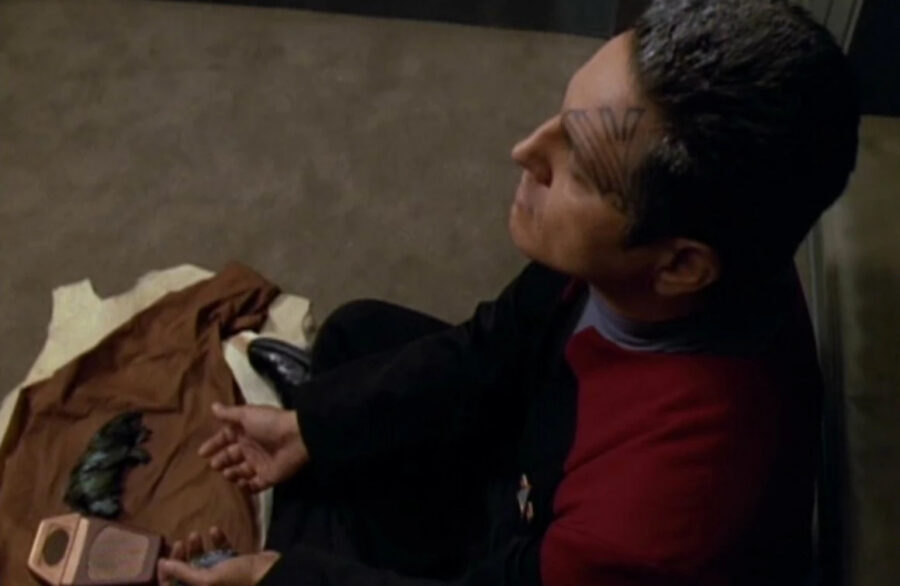
While the original Trek included characters based on their share of racial stereotypes, Scotty’s obsession with drinking Scotch for instance, it didn’t entirely rely on them. Scotty didn’t wear a kilt in the engine room and Chekov, despite a tendency to credit Russia with every great advancement in human history, didn’t wander around trying to convince everyone to become communists. Sulu didn’t subsist entirely on a diet of sushi, instead, he was really into the Three Musketeers and Euro-style swashbuckling. And that was in the 60s.
Voyager was on the air in 2001 and yet contained a character whose only reason for existing was to wander around the ship espousing the benefits of using high-tech, electronic peyote. It’s amazing he didn’t find a way to convert one of the cargo bays into a casino or make a uniform out of buffalo.
It all makes sense when you discover that the character of Chakotay was invented by a man famous for being a Native American fraud. His name was Jamake Highwater and in the 80s he passed himself off as a Native American in order to book lucrative consulting gigs.
But Jamake Highwater wasn’t Native American and in 1984, an investigative journalist exposed him. Somehow the producers of Voyager missed this expose and nearly 10 years later in 1993, they hired him to help come up with the character of Chakotay, believing Highwater actually knew something about Native Americans. It seems what he told them is that Native Americans like smoking peyote.
The Lower The Rank The Better The Character
And now we’re coming to the root of the problem. The thing is, Voyager’s most interesting characters are the ones they haven’t put in charge of anything. The Captain’s a bleeding heart, borderline incompetent obsessed with coffee (ok, the coffee thing is actually pretty great). The first officer is probably high, and their chief engineer is a space-faring Debbie Downer.
The rest of the bridge crew isn’t much better. Garret Wang’s Ensign Kim eventually turns into a passably interesting member of the ensemble, but Tom Paris’s receding hairline isn’t very convincing as some sort of devil-may-care bad boy.
Plus, Paris is romantically interested in B’Elanna Torres, so something is clearly wrong with this guy. I’m not even sure the ship’s security officer, Tuvok, despite the pointed ears, is actually a Vulcan.
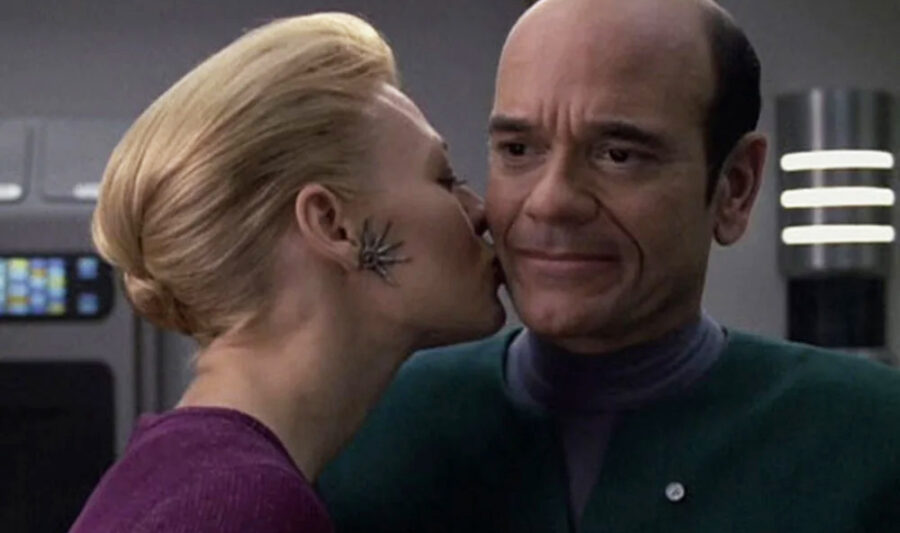
The show’s best characters are a holographic Doctor who spends most of his time confined to sickbay and probably isn’t real anyway, an alien explorer who they’ve decided to stick behind a stove in their kitchen, and a recently liberated, unusually attractive Borg (Jeri Ryan) who spends her time standing around in a cargo bay or sitting in front of a map somewhere in the bowels of the ship.
The show, of course, realized how great those characters were quickly, resulting in a steady diet of episodes centered around The Doctor, Neelix, and later on Seven of Nine. But since they aren’t really in charge of anything, it’s kind of hard to keep inventing excuses for the ship’s cook to go on away missions.
Star Trek Voyager’s Squandered Premise
The show’s inconsistent cast of characters is a side effect of a much larger problem and it’s this: they never knew what to do with their premise. It’s actually a really good premise, one which could have revitalized the entire Star Trek universe by standing it on its head.
A by-the-numbers Starfleet vessel is stranded so far away from home, it’ll take them 70 years to get back. They don’t have any resources, they don’t know where they are, and when half their crew is killed, they’re forced to replace them with a bunch of rebellious, borderline space pirates and make them their bunkmates. How does Voyager respond to this predicament? They decide to pretend they’re still in Starfleet and keep doing everything by the book.
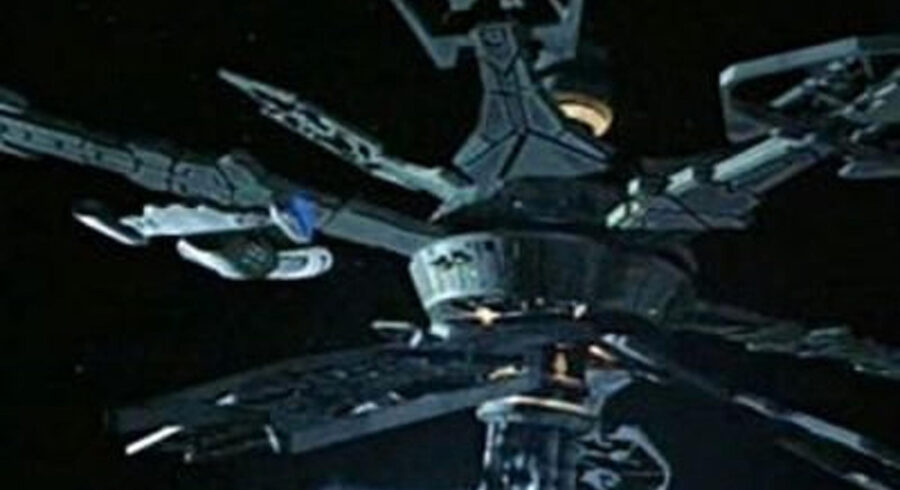
Oh, and those rebel marauders, the Maquis? By episode two, they’re virtually indistinguishable from every other Starfleet officer on the ship. They put on the uniform, follow the rules, and aside from the occasional plot line involving the holodeck, the differences between them and the actual Starfleet crew are almost never mentioned again.
The most frustrating thing about Voyager is that they used a show about a stranded ship in desperate circumstances to tell stories that could have been told on almost any old episode of Star Trek. Rather than being a staple of the stories they chose to tell, the Voyager crew’s predicament is more like a sidebar that the show’s writers stop to revisit whenever they don’t seem to have anything better to do.
Technology Babble
Among the list of things Voyager’s writers would rather do than address the show’s central premise is to spend time on the holodeck. In fact, Voyager spent more time on the holodeck than almost any other Star Trek has before or since. Rather than dealing with the real world, a large percentage of the show’s episodes involve dealing with holographic worlds where the crew battles B-movie sci-fi villains, engages in Klingon rituals, or occasionally has sex with holographic Irish bartenders.
Hey, she may be a Captain, but Kathryn Janeway is still a woman with needs, needs which she meets with a futuristic sex doll while wearing a variety of frilly dresses. It’s not only the show’s overuse of the holodeck that’s the problem, it’s their overuse of nearly every technological marvel they think fans might love.
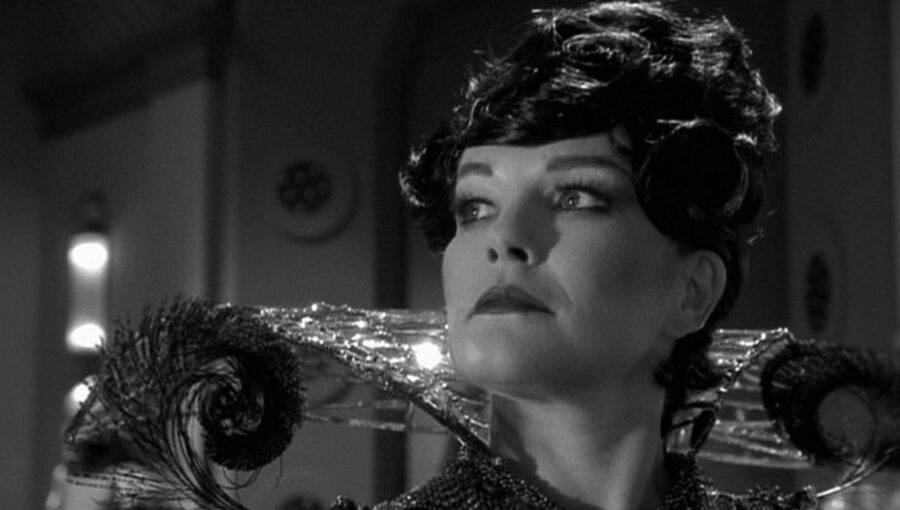
All too often, Star Trek: Voyager feels more like fan service than an actual storytelling venue. Replicators are used so much, they become less technology than magic. They’re the instant solution to any problem, problems which might have been more interesting if they couldn’t be solved by pushing a button. Running out of shuttles? No problem, we’ll replicate a dozen more so you can blow them up again. Need something to eat? Replicate it! Running out of replacement parts? Replicate them!
Other Trek technological staples get overused too, whether it’s the transporters or the turbolift or the warp engine, or the ship’s sensors … at some point all that once-marvelous technology becomes so overused that it loses any and all meaning. It stops becoming technology and becomes a series of magic MacGuffins the writers use whenever they get lazy.
The Legacy Of Star Trek Voyager
Star Trek: Voyager’s legacy is the story of ultimate opportunity paired with inconsistent execution. Voyager had a few great moments, but most of all, it had potential. Lots of it. It could have been the best of Star Trek and instead turned into something that never quite was what it deserved to be, and the place where the franchise started to fracture.
Since Voyager, Star Trek has seen a series of stops and starts. In 2009, the franchise got a soft reboot and now that soft reboot has basically stalled out after a weak box office performance by the third film. More recently, Paramount has started launching a new slate of Star Trek television shows. The first two of those shows, Discovery and Picard, routinely end up on fan lists as the worst things Trek has ever done.
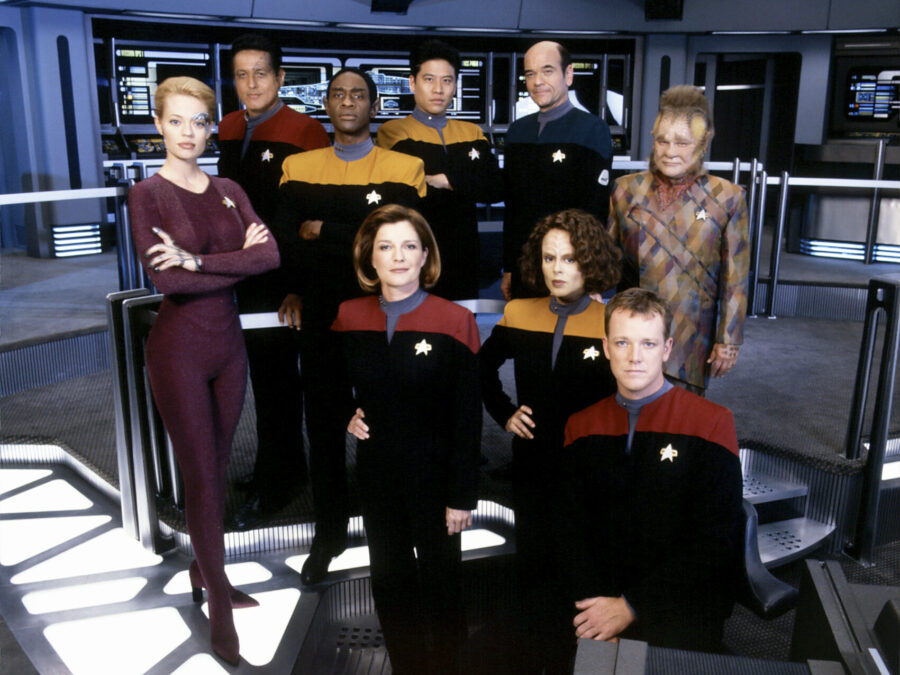
There’s hope though. There’s a well-received animated series called Lower Decks, set shortly after the events of Star Trek: Voyager. Also, the third live-action Star Trek series launched by Paramount, called Star Trek: Strange New Worlds, has earned largely positive response from critics and fans alike.
The series is part of the established canon and tells the story of the USS Enterprise’s second captain (Kirk was the third) Christopher Pike. It pushes Trek back in time, away from the era of Voyager and back to its more basic, let’s-see-what’s-out-there ’60s style roots.
So maybe Voyager was the first step towards putting Trek in a coma. But with Strange New Worlds, that coma appears to be ending and the future may be bright. And in the end, despite a few mistakes, Voyager was still Star Trek. Real Star Trek, far better than anything we’ve gotten from the franchise on a consistent basis since. Voyager had its triumphs. Bask in the warm glow of one of those triumphs with our look back at Star Trek Voyager‘s Best Episode.











